Digital minimalism is a philosophy that encourages a mindful and intentional approach to technology use. It’s about cutting back on unnecessary digital distractions and focusing on what truly matters in life. By decluttering your digital life, you can regain control over your time, attention, and overall well-being. It’s not about completely eliminating technology, but rather using it mindfully and selectively to enhance your life.
Our world is more connected than ever before, thanks to the rise of technology. Smartphones, social media, and countless apps have become an integral part of our daily lives. While these advancements offer incredible benefits, they also come with a hidden cost. Excessive technology use has become a pervasive issue, impacting our mental health, relationships, and overall well-being.
Constant notifications, endless scrolling, and the fear of missing out (FOMO) have created a culture of distraction and burnout. Many people find themselves struggling to disconnect, leading to sleep disturbances, decreased productivity, and feelings of isolation.
Enter Cal Newport, a renowned author and professor who has become a leading voice in the fight against digital distraction. His groundbreaking book, Digital Minimalism: Choosing a Focused Life in a Noisy World, offers a refreshing and practical approach to taming our technology habits. Newport challenges the notion that constant connectivity is essential for success and well-being. Instead, he proposes a more intentional and minimalist approach to technology use.
Table of Contents
The Negative Impacts of Constant Digital Consumption:
Constant digital consumption has far-reaching consequences for our well-being. One of the most significant impacts is on mental health. Excessive screen time has been linked to increased levels of anxiety, depression, and loneliness. The constant comparison to idealized online lives can fuel feelings of inadequacy and low self-esteem. Moreover, the fear of missing out (FOMO) perpetuated by social media can lead to chronic stress and anxiety.
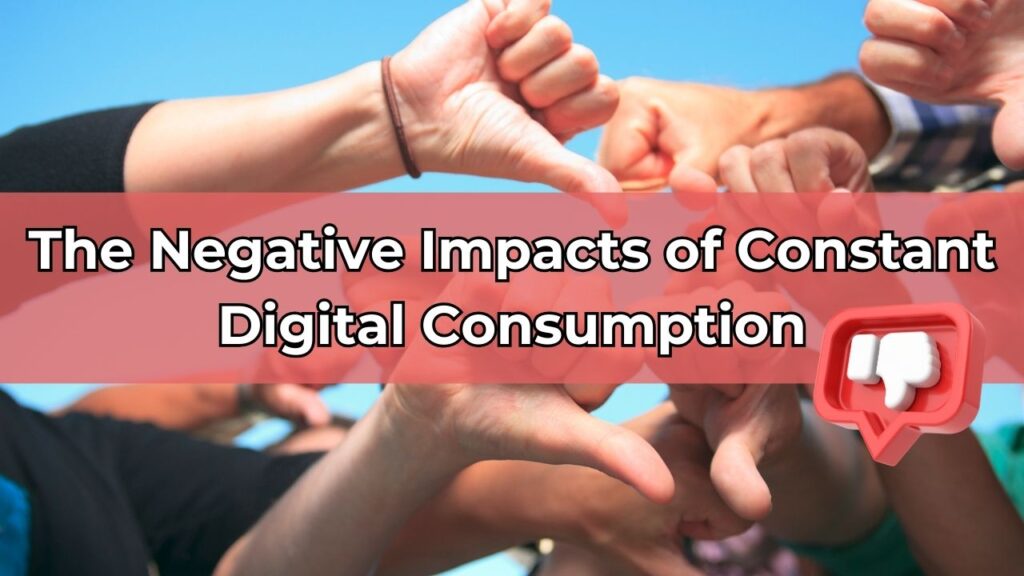
Beyond mental health, digital overload also hampers productivity and focus. The constant stream of notifications and distractions disrupts our ability to concentrate on tasks, leading to decreased efficiency and lower quality work. Additionally, the blue light emitted by screens can interfere with sleep patterns, further exacerbating focus issues.
Our relationships can also suffer from excessive digital consumption. Spending more time on screens means less quality time with loved ones. Shallow online interactions often fail to provide the same level of connection and intimacy as face-to-face interactions. This can lead to feelings of isolation and strained relationships.
Finally, there are growing concerns about the impact of digital consumption on physical health. Spending prolonged periods sitting in front of screens contributes to sedentary lifestyles, increasing the risk of obesity, heart disease, and other chronic illnesses. Furthermore, the blue light emitted by screens can disrupt sleep patterns, leading to fatigue, eye strain, and headaches.
The Core Principles of Digital Minimalism:
Digital minimalism is built upon three fundamental principles:
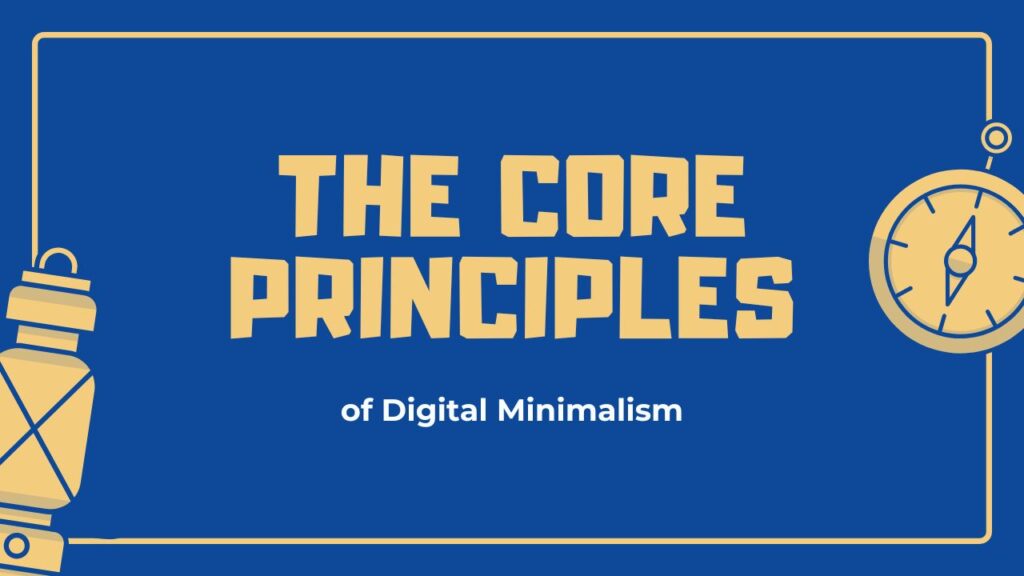
- Intentionally Selecting Digital Tools: Rather than accumulating a vast array of apps and platforms, digital minimalists carefully choose the tools that truly enhance their lives. This involves considering the value each tool brings and eliminating those that contribute to distraction or time wastage.
- Focusing on High-Quality Leisure Activities: Digital minimalism encourages a shift towards meaningful and enriching offline experiences. By prioritizing high-quality leisure activities, such as reading, spending time in nature, or cultivating hobbies, individuals can restore balance and find deeper fulfillment.
- Cultivating Deeper Connections: In an increasingly digital world, authentic human connection is more important than ever. Digital minimalists prioritize face-to-face interactions and meaningful relationships. By reducing digital distractions, they create more space for genuine connections and deeper bonds with loved ones.
Benefits of a Digital Minimalist Lifestyle:
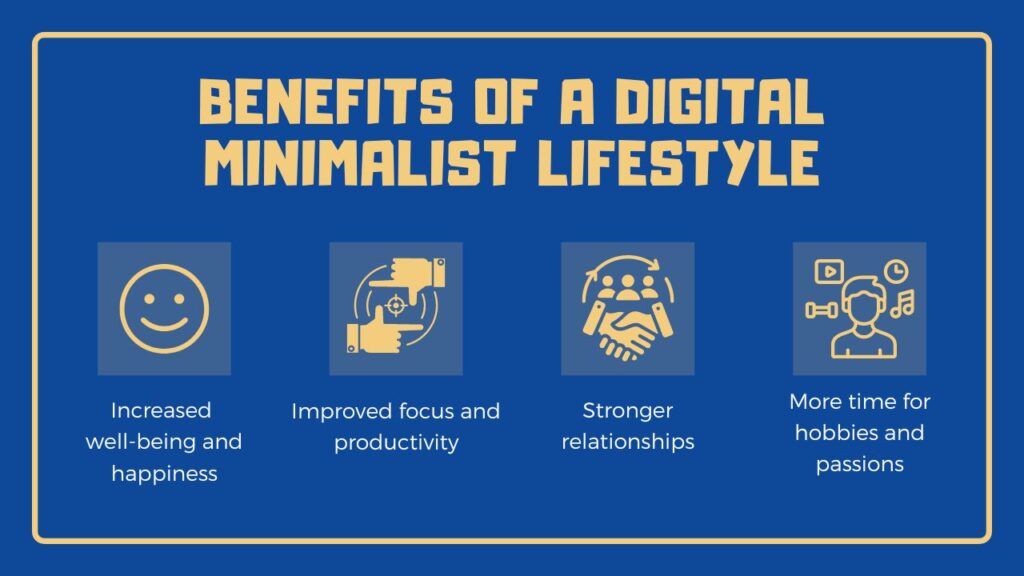
Embracing a minimalist approach to technology yields significant rewards. One of the most noticeable benefits is increased well-being and happiness. By reducing digital distractions, individuals experience less stress, anxiety, and FOMO. They have more time to engage in activities that bring joy and fulfillment, leading to a greater sense of life satisfaction.
Digital minimalism also contributes to improved focus and productivity. When freed from constant notifications and interruptions, people can concentrate better on tasks, leading to increased efficiency and higher quality work. Additionally, better sleep quality, resulting from reduced screen time, enhances cognitive function and overall productivity.
Stronger relationships flourish when individuals prioritize face-to-face interactions over digital connections. By dedicating more time and attention to loved ones, people can deepen their bonds and create lasting memories. Digital minimalism fosters a more present and engaged approach to relationships.
Finally, a minimalist lifestyle provides more time for hobbies and passions. With fewer digital distractions, individuals can explore their interests, learn new skills, and pursue creative endeavors. This newfound freedom can lead to personal growth, fulfillment, and a richer life experience.
Practical Steps to Digital Minimalism:

The 30-Day Digital Declutter:
Cal Newport’s Digital Minimalism introduces a transformative 30-day declutter process designed to reset your relationship with technology. This isn’t about becoming a Luddite but rather about reclaiming control over your digital life.
The first step is to identify your “optional technologies.” These are the digital tools and platforms that aren’t essential for work or critical communication. Social media, streaming services, online gaming, and many apps likely fall into this category.
For the next 30 days, you’ll eliminate these optional technologies from your life. This might sound drastic, but it’s a crucial step to break free from habitual digital consumption. The goal is to create a void where you can rediscover neglected passions, hobbies, and relationships.
Don’t fear boredom. This period is an opportunity for reflection, creativity, and rejuvenation. Engage in activities you’ve been putting off, spend quality time with loved ones, explore nature, or simply relax. This time is about rediscovering yourself without the constant digital stimulation.
After the 30 days, it’s time to rebuild your digital life intentionally. Reintroduce optional technologies one by one, asking yourself:
- Does this technology truly enhance my life?
- How will I use it mindfully?
- Are there specific times and places for using this technology?
Create rules and boundaries to prevent a relapse into old habits. For instance, designate specific times for checking emails or social media, or establish technology-free zones in your home.
Remember, the goal isn’t to eliminate technology entirely but to use it as a tool, rather than a master. By following this process, you’ll gain a newfound appreciation for your time, energy, and the real world.
Actionable Steps to a Digital Minimalist Lifestyle:
Embarking on a digital minimalism journey requires conscious effort and practical strategies. Here’s a deeper dive into actionable steps to help you cultivate a healthier relationship with technology:
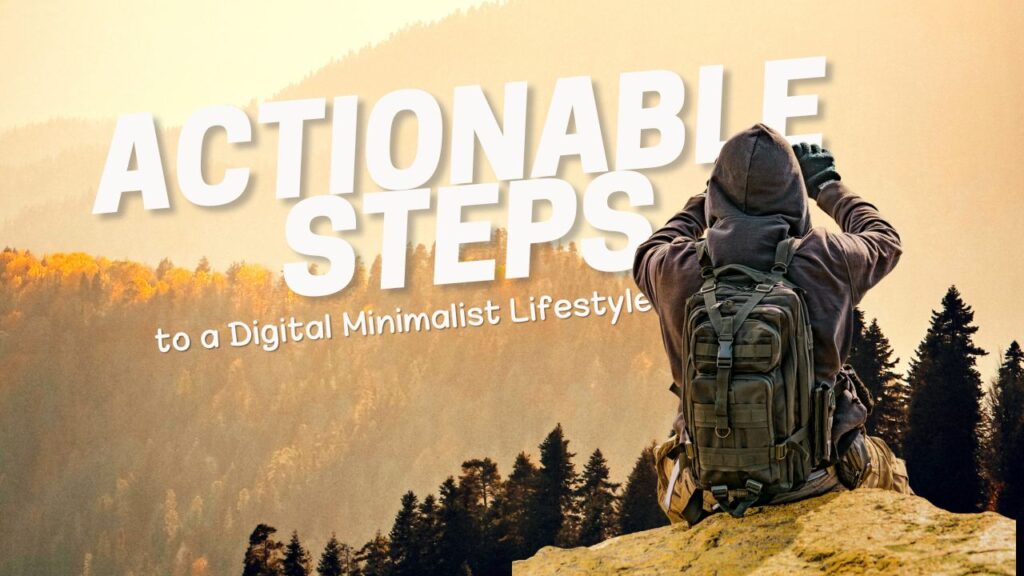
Social Media Detoxification:
- Identify your triggers: Understand why you reach for social media. Is it boredom, procrastination, or a need for validation?
- Create alternative habits: When the urge to scroll strikes, replace it with activities like reading, exercising, or spending time in nature.
- Set boundaries: Establish specific times for social media consumption and stick to them. Consider using app timers or blocking apps during focused work or relaxation periods.
- Quality over quantity: Focus on following accounts that inspire, educate, or entertain you, rather than mindlessly consuming content.
- Offline experiences: Prioritize real-world interactions and activities over virtual ones.
Mindfulness and Digital Well-being:
- Mindful technology use: Become aware of your technology habits and the impact they have on your mood and energy levels.
- Digital detox retreats: Schedule regular breaks from technology to recharge and reconnect with yourself.
- Screen time hygiene: Establish healthy screen time routines, especially before bed.
- Mindfulness apps: Explore apps that offer guided meditations, breathing exercises, and mindfulness techniques.
- Nature connection: Spend time outdoors to counterbalance screen time and reduce digital fatigue.
Time Management and Productivity:
- Time blocking: Allocate specific time blocks for focused work, personal activities, and digital consumption.
- Prioritization: Identify essential tasks and eliminate time-wasting activities.
- Pomodoro Technique: Work in focused 25-minute intervals followed by short breaks to enhance productivity.
- Digital decluttering: Regularly review your apps and files, deleting or organizing as needed.
- Single-tasking: Focus on one task at a time to improve concentration and efficiency.
Creating Healthy Digital Boundaries:
- Technology-free zones: Designate specific areas of your home as technology-free sanctuaries.
- Screen-free evenings: Establish a routine where you disconnect from screens after a certain time.
- Digital Sabbaths: Take regular breaks from technology to rest and recharge.
- Mindful consumption: Be selective about the information you consume and avoid overwhelming yourself with news or social media.
- Limit notifications: Turn off non-essential notifications to reduce distractions.
Remember, the goal is not to eliminate technology entirely but to use it mindfully and intentionally. By implementing these strategies, you can regain control over your digital life and create a more balanced and fulfilling existence.
Conclusion:
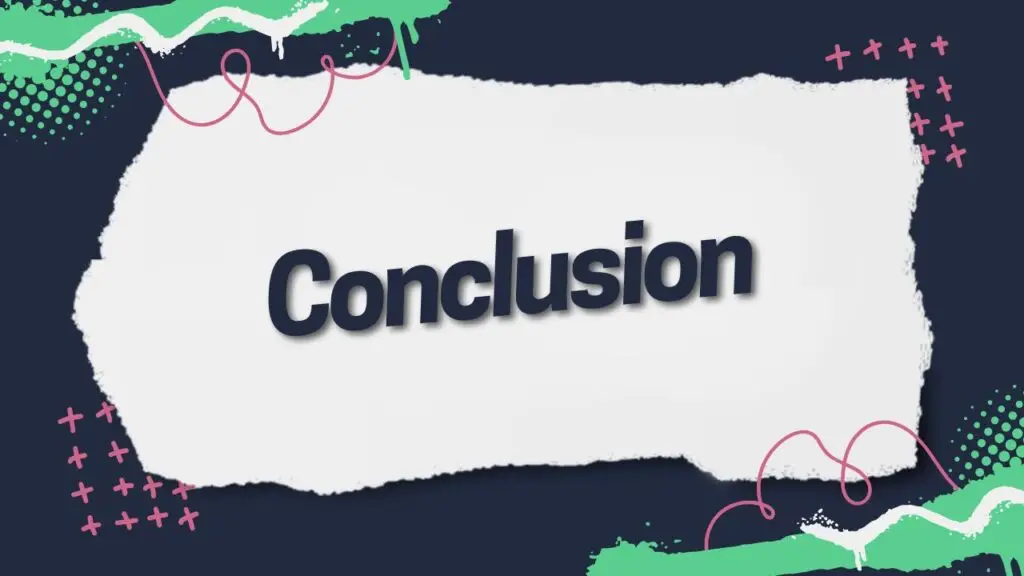
In an era dominated by constant connectivity and information overload, digital minimalism offers a refreshing counterpoint. By consciously curating our digital lives, we reclaim agency over our time, attention, and overall well-being. It’s not about denying the benefits of technology but about harnessing its potential while mitigating its drawbacks.
Digital minimalism isn’t a rigid prescription but a personalized journey towards a more fulfilling life. It’s about discovering what truly matters to you and creating a digital environment that supports your goals and values. By prioritizing real-world experiences, cultivating deeper connections, and engaging in meaningful pursuits, you can unlock a sense of freedom and clarity that often feels elusive in our fast-paced world.
Remember, progress, not perfection, is the key. Small, incremental changes can lead to significant improvements in your digital well-being. Start by identifying areas of your digital life that feel overwhelming or draining. Experiment with different strategies, such as decluttering your apps, setting boundaries, or incorporating mindfulness practices.
Digital Minimalism by Cal Newport provides a roadmap for this transformative journey. Newport’s insights and practical guidance offer invaluable support as you navigate the complexities of modern life. By investing in this book, you’re investing in yourself and your future.
Are you ready to embark on this journey of rediscovery? Take the first step towards a more intentional and fulfilling life by embracing the principles of digital minimalism. Your future self will thank you.
Purchase your copy of Digital Minimalism today and start building a life that truly matters.
